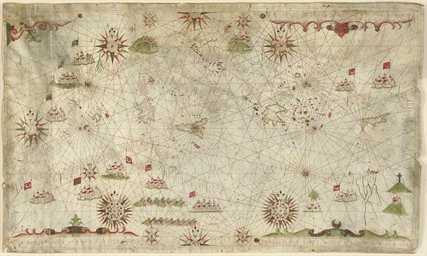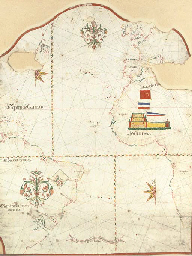A PORTOLAN CHART OF EUROPE. [Genoa: first quarter of the 16th Century]. Single vellum sheet, maximum dimensions 670 x 1120mm., including an extension section to accommodate the Atlantic Islands, verso blank, the chart extending from the Canaries to the Sea of Azov, from Norway and Iceland to the Nile, coastlines in sepia, islands in red, blue and green, rivers and lakes in green, over 1200 place-names in red and sepia in a small neat gothic rotunda, 76 detailed town vignettes, including all the major towns of the Mediterranean and the capitals of Northern and central Europe, all surmounted by flags heightened in silver and gold, mountains in North Africa, Spain and Northern Europe in crimson elongated formations, the islands of Cosica, Sardinia, Sicily, Crete and Cyprus decorated with flag symbols, large image of King Solomon holding a pair of dividers depicted in Egypt, the area of Norway decorated with a carefully drawn scene of mountains, sea-birds and a castle. Four scale bars set in the upper and lower margins, the chart extending through the northern scale bars, rhumblines in sepia, red and green, seven descriptive notes for the areas of northern Africa, Iceland, Norway, a Baltic island, two for Russia and a note for King Solomon. (Small holes along Atlantic edge for a former roller bar, cut at neck for tie, a few small minor holes, small area of western Europe rubbed with loss of rhumblines, rivers and two towns.) Provenance : John Alfred Spranger, bequeathed to the present owner, his daughter Elizabeth Graff. A VERY UNUSUAL UNRECORDED ANONYMOUS PORTOLAN CHART OF EUROPE which may be attributed to a Genoan chart-maker, probably drawn in the first quarter of the 16th Century. The chart shows no direct relation to any known surviving chart and in many respects falls between the established 'schools' of chart making, although it adopts some of the features of Catalan style and flamboyancy, such as the use of arms decorating the islands and the depiction of the figure of Soloman, yet the form and type of flag depiction, absence of compass roses and symbols to Majorca and the style of the chart reflects the austerity of Italian 15th century charts. The chart is loosely constructed, the misregistering of the two rhumbline systems at the centre of the Mediterranean suggest a lack of care, the extension of the chart above the northern scale bars beyond the rhumbline system to depict the Baltic and Norway is somewhat awkward, and the extension vellum strip for the standard Atlantic islands suggests a miscalculation on the part of the chart-maker, and in addition the lack of either windroses or compass roses must be a considered as either an error or a suggestion that this chart was not finished. The chart appears to derive from several sources, borrowing the main features from a normal Italian Mediterranean chart, embellishing it with a curious flamboyancy in the form of mountain depiction, and adding a most unusual depiction of Norway: the form of the Baltic is to be seen on many charts of this period. The fact that the island of Malta is not decorated with the Cross of the Knights of St. John suggests a date before 1530, while the depiction of Crete with the Venetian Lion symbol is most unusual, a crest being the normal way of decoration. Whilst all portolan charts are rare, portolan charts of the whole of Europe on one skin are very scarce. This chart is a fine example of how the pure style of the Italian chart-maker became influenced by later Catalan traditions, and was undoubtably produced for display for a wealthy Genoese client, whose trade interests were spread beyond the Mediterranean.
A PORTOLAN CHART OF EUROPE. [Genoa: first quarter of the 16th Century]. Single vellum sheet, maximum dimensions 670 x 1120mm., including an extension section to accommodate the Atlantic Islands, verso blank, the chart extending from the Canaries to the Sea of Azov, from Norway and Iceland to the Nile, coastlines in sepia, islands in red, blue and green, rivers and lakes in green, over 1200 place-names in red and sepia in a small neat gothic rotunda, 76 detailed town vignettes, including all the major towns of the Mediterranean and the capitals of Northern and central Europe, all surmounted by flags heightened in silver and gold, mountains in North Africa, Spain and Northern Europe in crimson elongated formations, the islands of Cosica, Sardinia, Sicily, Crete and Cyprus decorated with flag symbols, large image of King Solomon holding a pair of dividers depicted in Egypt, the area of Norway decorated with a carefully drawn scene of mountains, sea-birds and a castle. Four scale bars set in the upper and lower margins, the chart extending through the northern scale bars, rhumblines in sepia, red and green, seven descriptive notes for the areas of northern Africa, Iceland, Norway, a Baltic island, two for Russia and a note for King Solomon. (Small holes along Atlantic edge for a former roller bar, cut at neck for tie, a few small minor holes, small area of western Europe rubbed with loss of rhumblines, rivers and two towns.) Provenance : John Alfred Spranger, bequeathed to the present owner, his daughter Elizabeth Graff. A VERY UNUSUAL UNRECORDED ANONYMOUS PORTOLAN CHART OF EUROPE which may be attributed to a Genoan chart-maker, probably drawn in the first quarter of the 16th Century. The chart shows no direct relation to any known surviving chart and in many respects falls between the established 'schools' of chart making, although it adopts some of the features of Catalan style and flamboyancy, such as the use of arms decorating the islands and the depiction of the figure of Soloman, yet the form and type of flag depiction, absence of compass roses and symbols to Majorca and the style of the chart reflects the austerity of Italian 15th century charts. The chart is loosely constructed, the misregistering of the two rhumbline systems at the centre of the Mediterranean suggest a lack of care, the extension of the chart above the northern scale bars beyond the rhumbline system to depict the Baltic and Norway is somewhat awkward, and the extension vellum strip for the standard Atlantic islands suggests a miscalculation on the part of the chart-maker, and in addition the lack of either windroses or compass roses must be a considered as either an error or a suggestion that this chart was not finished. The chart appears to derive from several sources, borrowing the main features from a normal Italian Mediterranean chart, embellishing it with a curious flamboyancy in the form of mountain depiction, and adding a most unusual depiction of Norway: the form of the Baltic is to be seen on many charts of this period. The fact that the island of Malta is not decorated with the Cross of the Knights of St. John suggests a date before 1530, while the depiction of Crete with the Venetian Lion symbol is most unusual, a crest being the normal way of decoration. Whilst all portolan charts are rare, portolan charts of the whole of Europe on one skin are very scarce. This chart is a fine example of how the pure style of the Italian chart-maker became influenced by later Catalan traditions, and was undoubtably produced for display for a wealthy Genoese client, whose trade interests were spread beyond the Mediterranean.

.jpg)


.jpg)










Testen Sie LotSearch und seine Premium-Features 7 Tage - ohne Kosten!
Lassen Sie sich automatisch über neue Objekte in kommenden Auktionen benachrichtigen.
Suchauftrag anlegen